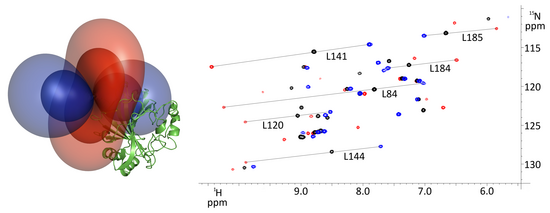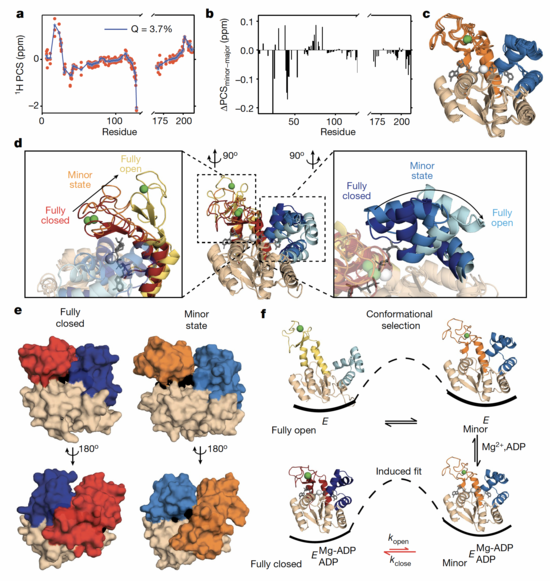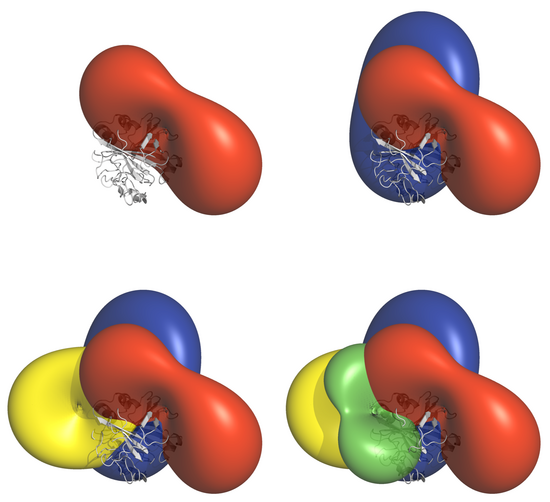Introduction and overview

Representation of pseudocontact shift isosurfaces for a Tm3+-loaded lanthanide chelating tag conjugated to hCA (left). 1H-15N HSQC NMR spectra of 15N leucine labeled human Carbonic Anhydrase (hCA) tagged with different lanthanides: Dy: blue, Tm: red, Lu: black (right).
Nuclear magnetic resonance spectroscopy provides an ideal toolbox for elucidating structure, dynamics and interactions of biomacromolecules in solution, since the offered possibility to tune and adjust the experimental conditions, i.e. buffer components, salt concentration, additives, temperature and pH, yields realistic and atomic-resolution structures of biomacromolecules under physiological conditions. In order to study protein-protein or protein-ligand interactions as well as the positioning and conformation of flexible domains within proteins in solution, long-range structural restraints are urgently needed. Paramagnetic nuclear magnetic resonance spectroscopy, more specifically pseudocontact shifts and residual dipolar couplings generated by lanthanide chelating tags, can deliver such long-range restraints and thereby render amenable the structural analysis of large protein complexes as well as protein-ligand binding in solution.
"Pseudocontact Shifts in Biomolecular NMR Spectroscopy."
Thomas Müntener, Daniel Joss, Daniel Häussinger,* and Sebastian Hiller*, Chemical Reviews, 2022, 122, 9422-9467.
"Intrinsic anisotropy parameters of a series of lanthanoid complexes deliver new insights into the structure-magnetism relationship."
R. Vogel, T. Müntener, D. Häussinger, Chem, 2021, 7, 3144-3156.
"Design and application of lanthanide chelating tags for pseudocontact shift nuclear magnetic resonance spectroscopy on biomacromolecules."
D. Joss, D. Häussinger, Progress in Nuclear Magnetic Resonance Spectroscopy, 2019, 114-115, 284-312.
Design of next-generation lanthanide chelating tags

Overlay of DFT structures of Lu-P4T-DOTA and Lu-P4M4-DOTA and their structures (left, attachment point of the protein’s cysteine residue in magenta). Selection of induced shifts by the strongly paramagnetic Tm- and Dy-P4T-DOTA (right).
In order to generate strongly paramagnetic lanthanide chelating tags that are sufficiently immobilized on the surface of the protein and generate thereby large paramagnetic effects, i.e. large pseudocontact shifts and residual dipolar couplings, we synthesize sterically overcrowded DOTA-derived lanthanide chelating tags with different linker systems. More specifically, the introduction of sterically demanding substituents, e.g. isopropyl groups, as well as the introduction of novel, reduction-stable linker moieties, e.g. pyridinethiazole derivatives, proved to be highly beneficial in order to generate lanthanide chelating tags with optimal properties and general applicability.
"P4T-DOTA - A lanthanide chelating tag combining a highly sterically overcrowded backbone with a reductively stable linker."
D. Joss, D. Häussinger, Chemical Communications, 2019, 55, 10543-10546.
"A sterically overcrowded, isopropyl-substituted lanthanide chelating tag for protein PCS NMR spectroscopy: Synthesis of its macrocyclic scaffold and benchmarking on ubiquitin S57C and hCA II S166C."
D. Joss, M.-S. Bertrams, D. Häussinger, Chemistry - A European Journal, 2019, 25, 11910-11917.
"New Lanthanide chelating tags for PCS NMR spectroscopy with reduction stable, rigid linkers for fast and irreversible conjugation to proteins."
T. Müntener, J. Kottelat, A. Huber, D. Häussinger, Bioconjugate Chemistry, 2018, 29, 3344-3351.
Applications of lanthanide chelating tags

The high-energy state of Adk during enzyme catalysis.a, PCS identifications for minor state after maximum-likelihood calculation from experimental data. Low Q values indicate a good correspondence between the back-calculated and identified PCSs. b, The difference in PCS between major and minor state. c, The top five highest likelihood structures of the minor state solved by the expectation-maximization simulated annealing protocol. The position of Zn2+ or Co2+ is shown as a green sphere; the catalytic Mg2+ coordinating two ADP substrates is shown as a white sphere. d, Structural comparison of the major closed state (blue and red), average minor state (light blue and orange) and open structure (cyan and yellow). The ATP lid shows slight opening in the minor state with a 1.8 Å change in metal position (left). The AMP lid domain shows greater movement with approximately 50% transition from a closed to open conformation (right). e, Surface representation of the closed crystal structure (left) and minor state (right) in front and side view (nucleotides are shown in black and Mg2+ as a white sphere). f, Proposed mechanism for substrate binding and product release, including conformational selection for substrate binding to the minor state, followed by an induced-fit step of full closure over the nucleotides.
Macromolecular function frequently requires that proteins change conformation into high-energy states1–4. However, methods for solving the structures of these functionally essential, lowly populated states are lacking. Here we develop a method for high-resolution structure determination of minorly populated states by coupling NMR spectroscopy-derived pseudocontact shifts5 (PCSs) with Carr–Purcell– Meiboom–Gill (CPMG) relaxation dispersion6 (PCS–CPMG). Our approach additionally defines the corresponding kinetics and thermodynamics of high-energy excursions, thereby characterizing the entire free-energy landscape. Using a large set of simulated data for adenylate kinase (Adk), calmodulin and Src kinase, we find that high-energy PCSs accurately determine high-energy structures (with a root mean squared deviation of less than 3.5 angström). Applying our methodology to Adk during catalysis, we find that the high-energy excursion involves surprisingly small openings of the AMP and ATP lids. This previously unresolved high-energy structure solves a longstanding controversy about conformational interconversions that are rate-limiting for catalysis. Primed for either substrate binding or product release, the high-energy structure of Adk suggests a two-step mechanism combining conformational selection to this state, followed by an induced-fit step into a fully closed state for catalysis of the phosphoryl-transfer reaction. Unlike other methods for resolving high-energy states, such as cryo-electron microscopy and X-ray crystallography, our solution PCS–CPMG approach excels in cases involving domain rearrangements of smaller systems (less than 60 kDa) and populations as low as 0.5%, and enables the simultaneous determination of protein structure, kinetics and thermodynamics while proteins perform their function.
Structure determination of high-energy states in a dynamic protein ensemble.
J.B. Stiller, R. Otten, D. Häussinger, P.S. Rieder, D.L. Theobald, D. Kern, Nature, 2022, 603, 528-535.

Tensors required for unambiguous localization of a given atom by using PCS as sole source of structural restraints. Top left: isosurface (red) and hCA II (grey). Top right: intersection of two isosurfaces. Bottom left: intersection of three isosurfaces resulting in two intersection points (one visible, one on the other side of the protein scaffold). Bottom right: intersection of four isosurfaces resulting in only one intersection point (visible in center).
The successful localization of ligands within biomacromolecules is crucial for drug development as well as the investigation of biological processes within cells. In order to unambiguously localize fluorinated ligands for the model protein human carbonic anhydrase II, we developed a pseudocontact shift based methodology that allows to obtain the position of the selected ligands over distances up to 38 Å with an accuracy of up to 0.8 Å within the protein scaffold.
"Localization of ligands within human carbonic anhydrase II using 19F pseudocontact shift analysis."
K. Zimmermann, D. Joss, T. Müntener, E. S. Nogueira, M. Schäfer, L. Knörr, F. W. Monnard, D. Häussinger, Chemical Science, 2019, 10, 5064-5072.

Introduction of tagged GB1 constructs into Xenopus laevis oocytes (left). Induced PCSs and RDCs in living cells at a field strength of 14.1 T (right).
Furthermore, it was shown for the first time that de novo protein structures can be determined within intact Xenopus laevis oocytes by analysis of pseudocontact shifts and residual dipolar couplings from a single set of 2D in-cell NMR experiments in combination with the Rosetta database. Thereby, structural ensembles of GB1 were conveniently derived from low concentration in-cell NMR samples (∼50 μM).
"In-cell protein structures from 2D NMR experiments."
T. Müntener, D. Häussinger*, P. Selenko, F.-X. Theillet*, Journal of Physical Chemistry Letters, 2016, 7, 2821-2825.

Induced PCS visible in 1H-15N TROSY-HSQC spectra of a SNARE complex (left). Correlation plot of experimental and calculated PCS (middle). Isosurfaces induced by the lanthanide chelating tag incorporated into the complex of biomacromolecules (right). Blue: positive PCS, Red: negative PCS, Black: position of lanthanide ion.
Besides the localization of ligands within biomacromolecules and the de novo structure determination of proteins in living cells, it was demonstrated by Brewer et al. that PCS contribute in valuable manner to the structure determination of large complexes of biomacromolecules. In the selected example, the researchers investigated the complex of biomacromolecules, i.e. Syt1 together with the SNARE complex (synaptobrevin, syntaxin-1 and SNAP-25), that is responsible for the rapid release of neurotransmitters.
"Dynamic Binding Mode of a Synaptotagmin-1-SNARE Complex in Solution."
K. Brewer, T. Bacaj, A. Cavalli, C. Camilloni, N. Barlow, A. Zhou, P. Cao, J. Xu, A. B. Seven, E. A. Prinslow, R. Voleti, D. Häussinger, A. Bonvin, J. Liu, D. R. Tomchick, M. Vendruscolo, B. Graham, T. C. Südhof, J. Rizo, Nature Structural & Molecular Biology, 2015, 22, 555-564.
